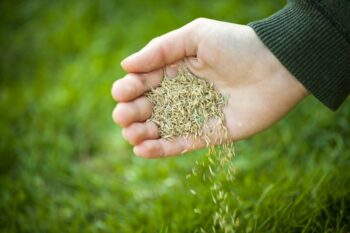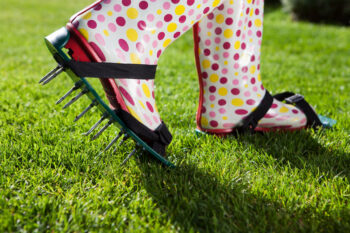
Overseed lawn in spring. Spring is the perfect opportunity to take your lawn to the next level. If you’re in Texas and want to give your lawn a makeover before summer, overseeding is an excellent option.
What Is Overseeding?
Overseeding is replanting grass seed directly into existing turf without removing any soil or existing grasses. It helps strengthen the overall quality of your lawn by increasing its density. Additionally, overseeding improves a lawns’ ability to resist disease and weeds. If done correctly, overseeding can be incredibly beneficial for Texas gardens in the springtime.
How to tell your lawn will benefit from overseeding
If your lawn looks a bit thin and patchy, there’s a good chance it needs overseeding. Fertilization will also help fill in bare spots. First, you need to do some testing to check that your soil is healthy and ready for seeding.
Here’s how:
- Check the soil’s pH balance using an at-home kit or sending a sample to a lab for testing.
- Monitor your soil’s temperature—warm-season grasses grow best when grounds remain between 65 and 85 °F.
- Examine the texture of your soil (coarse or fine) because this will determine how much water it can absorb and retain.
Once you’ve confirmed everything’s in order, you should proceed with overseeding. Spread grass seed over the existing turf and then cover it lightly with topsoil or compost per the instructions given on the package.
Choose the Right Grass Seed for your North Texas Lawn
Texas has various types of grass that can handle hot, humid summers and mild winters. The most common type of warm-season grasses used in Texas are Bermuda grass, St. Augustine grass, and Zoysia grass. Each type of grass has its unique qualities and pros and cons, so be sure you choose the right one for your lawn or garden based on your climate, location and soil type.
High-Quality Seed
Once you’ve chosen a type of seed that’s best for your lawn, you’ll want to make sure you’re buying high-quality sources with a reasonable germination rate—which means that more seeds will sprout after planting. High-quality seeds should have at least 75% germination rates and be free from weed seeds or other contaminants.
Best Time to Overseed a Lawn in Spring
The best time for overseeding in Texas is during late Spring or when temperatures climb, usually between March and May. Soil temperatures need to be around 65 degrees Fahrenheit. At this time, the soil is warm enough to energize new seed germination and help the grass establish strong roots while combating weeds.
How to Overseed Your Lawn in Spring
If you’d like to overseed your lawn in Spring, you’ll need to follow a few simple steps. It’s not difficult, and you don’t need any special tools, but you do need to pay attention to the details and take your time. Here’s how:
Step 1: Prepare the Soil
To prepare your soil for overseeding, remove any weeds or debris from the soil’s surface. It would be best to rake the area to create small furrows to hold the seed in place.
Step 2: Choose Your Seed Mixture & Apply It
Once your soil is prepared, choose a seed mixture and apply it. Select a seed mixture that is appropriate for your region and climate. Consult with local gardeners or a local nursery for advice about what type of grass would thrive in your area. Once you have decided on a seed mixture, sprinkle it over the entire area evenly, making sure not to spread more than recommended.
Step 3: Cover The Seeds & Water Regularly
Once your seeds are applied, cover them with an additional layer of soil or peat moss. This helps protect them as they begin to germinate. After covering the seeds, water them daily until they germinate and grow into new grass blades.
Do you need to aerate before overseeding?

Yes, it is recommended to aerate before overseeding to achieve optimal results. Aeration will allow the soil to fully absorb the seeds. You will definitely want to aerate beforehand if you have clay soil.
Clay soil
Clay soil is often compacted. Which can lead to difficulties in getting the seeds to take root. In this case, aerating your soil before overseeding is an important step. This will help break up any large clumps of dirt and allow water and air to penetrate deeper into the ground, promoting better grass growth.
Sandy or rocky ground
On the other hand, if your soil is sandy or rocky, aeration may not be necessary because the soils have natural drainage. Nevertheless, it is still beneficial to aerate as this will allow vigorous root growth.

Wrapping up
Overseeding your lawn in the Spring is a great way to revive it and make it look lush. Not to mention it’s an easy, cost-effective way to get a greener lawn once again. It’s worth investing in your lawn, so why not try?
Not ready to DIY? Consider putting down new sod. Sod installation will give you an instant green, lawn.
